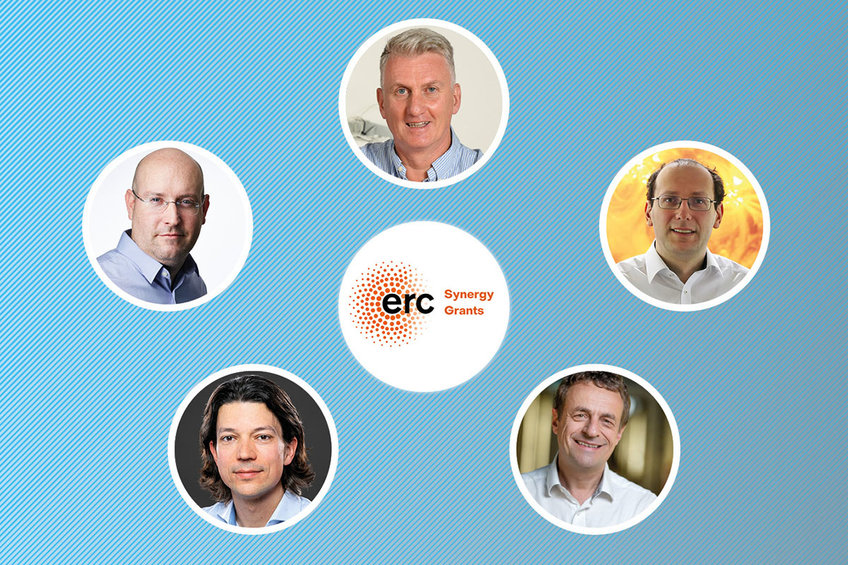Four Synergy Grants for five Max Planck researchers
The scientists and their research teams receive around 40 million euros in funding for their work
They want to develop a new mathematical language, research the regenerative abilities of the axolotl brain, are looking for habitable worlds outside our solar system and are working on transmitting scents via the internet. This year's ERC Synergy Grantees of the Max Planck Society have planned a lot.

A new mathematical language
A Synergy Grant was awarded to the UNIVERSE+ project. The team behind it aims to do nothing less than develop a new mathematical language. It will help describe physical phenomena, from the interactions of elementary particles to the large-scale structure of the Universe. Two of the four project leaders are directors of institutes at the Max Planck Society: the theoretical particle physicist Johannes Henn, coordinating project leader, works at the Max Planck Institute for Physics.
His colleague, mathematician Bernd Sturmfels, works at the Max Planck Institute for Mathematics in the Sciences in Leipzig. The other two in the team are particle physicist Nima Arkani-Hamed from the Institute for Advanced Study (Princeton, USA) and Daniel Baumann, whose research focuses on theoretical cosmology at the University of Amster-dam. A total of ten million euros is being invested in the project UNIVERSE+.
The axolotl's regenerative brain
Kevin Briggman, Director of our Department of Computational Neuroethology at Max Planck Institute for Neurobiology of Behavior - caesar, is part of the new ERC Synergy Grant AxoBrain that aims to understand the amazing regenerative abilities of the axolotl central nervous system. For decades, scientists have been studying how the Mexican salamander regenerates limbs after injuries, yet the molecular and circuit mechanisms behind regeneration of the brain are still poorly understood. By funding Axo-Brain with nine million Euro for the next six years, the European Research Council ERC enables the consortium to employ cutting-edge technologies to better understand how axolotl brain cells react to damage and how circuits and behavior are restored. Ultimately, this knowledge will contribute to a better understanding of vertebrate brain organisation and to developing potential strategies for regenerating nerve tissue in mammals. The project is a collaboration with senior group leader Elly Tanaka (project coordinator) from the Research Institute of Molecular Pathology (IMP) in Vienna and Barbara Treutlein, professor at ETH Zurich.
In search of life-friendly exoplanets
Successful together where a single team cannot solve a complex research problem alone. Through the combined expertise of scientists from the fields of stellar physics and exoplanet physics, the REVEAL project plans to complete one of the most exciting searches in modern astronomy: for habitable worlds outside our solar system. To do this, it is critical to understand how the activity of the observed stars translates into the measured data. Especially in the case of small, Earth-like planets, stellar activity obscures the traces left by the planet and its atmosphere in the starlight. Alexander Shapiro from the Max Planck Institute for Solar System Research is one of the three scientific leaders of REVEAL. His group is responsible for the stellar simulations using complex magneto-hydrodynamic models. Sara Seager's group from the Massachusetts Institute of Technology in the USA is looking for evidence of life-friendly atmospheres in measured data from NASA's James Webb Telescope. The research group led by Andrew Collier Cameron of the University of St Andrews is working on detecting and characterizing exoplanets using Earth-based spectrometers. The ERC is supporting the project with nearly €9.5 million over the next six years through an ERC Synergy Grant.
Digitizing Smell
The project D2Smell (Digitising Smell: From Natural Statistics of Olfactory Perceptual Space to Digital Transmission of Odors) has been awarded an ERC Synergy Grant of EUR 11.8 million, which is shared between three researchers: Jonathan Williams, Max Planck Institute for Chemistry, Johan Lundström, Karolinska Institutet and Noam Sobel, Weizmann Institute of Science, Israel. The interdisciplinary collaboration aims to digitally transfer scents to recreate them in another location.
A little statistics
In the most recent round of calls for ERC Synergy Grants 2023, 37 projects were selected for funding across Europe from 396 applications. Of these, the Max Planck Society was able to win four grants. This corresponds to a success rate of 16.7%. In total, 24 applications were submitted by Max Planck Institutes.
In a European comparison, the Max Planck Society ranks second with four grants acquired. First place is led by the Helmholtz Association with seven grants. The French Centre national de la recherche scientifique (CNRS), the Spanish Consejo Superior de Investigaciones Científicas (CSIC), the Karolinska Institute in Sweden and the University of Groningen occupy third place with three grants each.
The total of 37 funded projects involve 135 top European scientists who will carry out their work at 114 universities or research centers in 19 countries in the European Research Area and beyond. Germany (27), France (12), the Netherlands (7) and Israel (6) are the countries where most of the top researchers will work under the Synergy Grants.
The ERC Synergy Grants support projects consisting of a group of two to four individual scientists. The Synergy Grants are funded with up to 14 million euros per individual for a period of six years.












